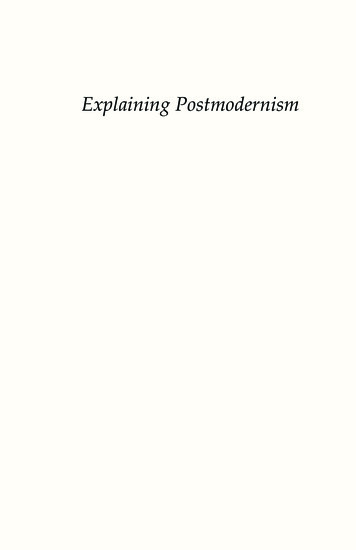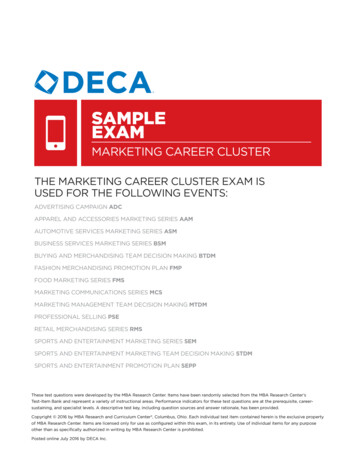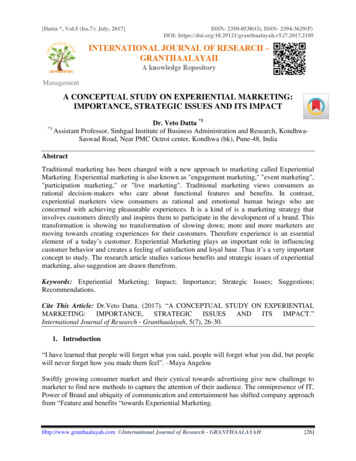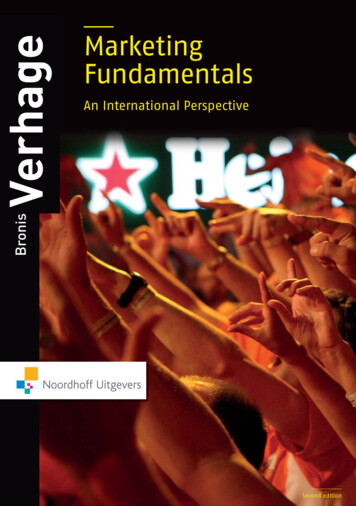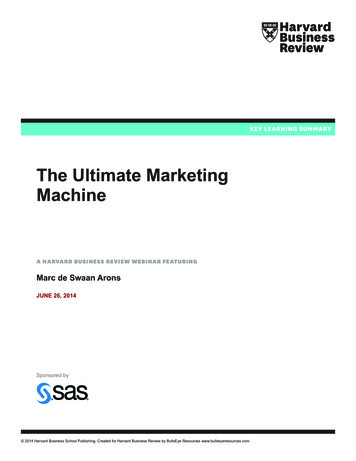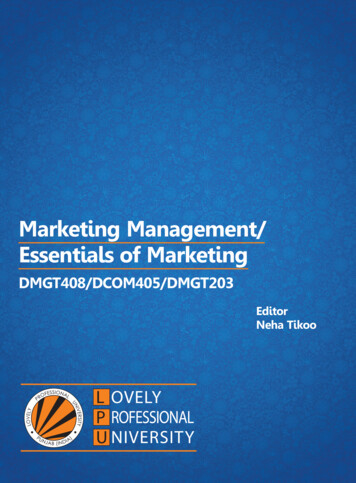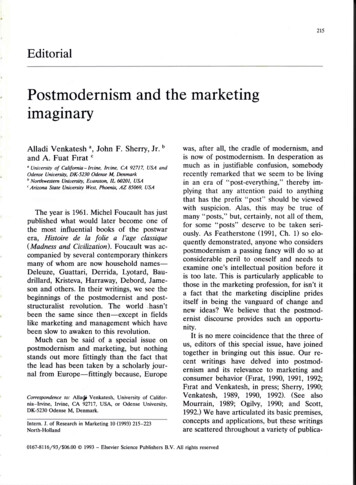
Transcription
zt5EditorialPostmodernismand the marketinglmaglnaryAlladi Venkateshu, John F. Sherry,Jr. band A. Fuat Frrat "o Uniuersityof Califumia-Iruine, Iruine, CA 92717,USA andOdenseUniuersiu, DK-5230 OdenseM, Denmarkb Northwestem Uniuenity, Euarcto4 IL ffi201, USA'Arizona State Uniuersity West,Phoenix,AZ 85069,USAThe year is 1961.Michel Foucaulthasjustpublishedwhat would later become one ofthe most influential books of the postwarera, Histoire de la folie a I'age classique(Madnessand Ciuilization).Foucaultwas accompaniedby severalcontemporarythinkersmany of whom are now householdnamesDeleuze, Guattari, Derrida, Lyotard, Baudrillard, Kristeva,Harraway,Debord, Jameson and others.In their writings,we see thebeginningsof the postmodernistand poststructuralist revolution. The world .hasn'tbeen the same since then-except in fieldslike marketing and managementwhich havebeen slow to awakento this revolution.Much can be said of a special issue onpostmodernismand marketing,but nothingstandsout more fittingly than the fact thatthe lead has been taken by a scholarlyjournal from Europe-fittingly because,EuropeCorrespondenceto: Alla(f Venkatesh, University of California-Iwine, Irvine, CA 9271,7,USA, or Odense University,DK-5230 OdenseM. Denmark.Intern. J. of Researchin Marketing10 (1993)215-223North-Hollandwas, after all, the cradle of modernism,andis now of postmodernism.In desperationasmuch as in justifiable confusion,somebodyrecentlyremarkedthat we seemto be livingin an era of "post-everything,"therebyimplying that any attention paid to anythingthat has the prefix "post" shouldbe viewedwith suspicion.Alas, this may be true ofmany"posts,"but, certainly,not all of them,for some "posts" deserveto be taken seri(1991,Ch. 1) so eloously.As Featherstonequentlydemonstrated,anyonewho considerspostmodernisma passingfancy will do so atconsiderableperil to oneself and needs toexamineone's intellectualposition before itis too late. This is particularly applicabletothosein the marketingprofession,for isn't ita fact that the marketing discipline pridesitself in being the vanguardof changeandnew ideas? We believe that the postmodernist discourseprovides such an opportunity.It is no mere coincidencethat the three ofus, editors of this specialissue,have joinedtogether in bringing out this issue.Our recent writings have delved into postmodernism and its relevanceto marketing andconsumer behavior (Frrat, 1990, 1991, 1992;Frrat and Venkatesh,in press;Sherry,L990;Venkatesh, 1989, 1990, 1992). (See alsoMourrain, 1989; Ogilvy, 1990; and Scott,1992.)We havearticulatedits basicpremises,conceptsand applications,but thesewritingsare scatteredthroughouta varietyof publica-0167-8116/93/ 06.00O 1993- ElsevierSciencePublishersB.V. All rightsreserved
A Venkatesh et al. / Postmodernism and the marketing imaginaryTable IRelative emphases in modernism and postmodernismModernist emphasisPostmodern emohasisObjectC a r t e s i a ns u b j e c tCognitive subjectUnified subjectCentered subjectImage, symbolSymbolic subjectSemiotic subjectFragmented subjectDecentered subjectSignifiedObjectificationRepresentationTruth h (constructed)RealUniversalismSociety as a structureHyperreall-ocalism, particularismSociety as a spectaclel,ogocentric reasonKnowingHermeneutic reasonCommunicatingEconomyCapitalismEconomic systemsProductionShift from use value toexchangevalueScience/TechnologyMechanical technologyCultureLate capitalismSymbolic systemsConsumptionShift from exchangevalueto sign uralism, globalismSciencesEuro-American centrismPhallocentrismOrientalism, colonialismtion outlets. For reasonsof space we areunable to repeat all the ideas discussedearlier, but urge interestedreadersto becomefamiliar with them for they providethe foundational ideas for the various articles included here. This does not mean that theuninitiated readerswill get no help from thearticlesincluded in the presentissuewhich,of course,contain many of the central ideas.It is just that their understandingwill bemade richer through a wider exposure.Foreasyreference,basedon previousliteratureand the articlesincludedhere,we havesummarized some important distinctions between modernism and postmodernism inTable 1. We have also includedExhibit 1 tofamiliarizethe readerswith some frequentlyused terminologywithin the postmodernistdiscourse.Readersare further encouragedtomake note of the referencesunder variousarticles included in this issuefor additionalreading.Postmodernism,alongwith poststructuralism, representsthe most fundamentaldevelopment in the history of ideas in the recentdecades.Although its origins can be tracedto the fields of architectureand art duringthe 1920sand 1930s,it is only in the lastdecadeor two that it has gained a momentum of a revolutionarynature and made animpact on numerousdisciplines.During thelate sixties and seventies,the explosion ofpostmodernistand poststructuralistideasfirstoccurred in areas such as literary theory,cultural studiesand philosophy,and, consequently, the fields with which we are mostconcerned,the social sciences(economics,sociologyetc.), managementand marketinghave remained largely unaffected by theforces of postmodernism(for an exception,see Journal of OrganizationalChangeManagement,vol. 5, no. 1). These fields can nolongerremain immune,and what is now perceivedas inevitablecan be explainedby thefact that postmodernismdealsboth with thebasicphilosophicaland culturalpremisesthatunderlie social scientific assumptionsandwith the foundationalideas surroundingournotionsof socialand economicreality (ontology).It treatsour knowledgestructures(epistemology),as well as our conceptualizationsof the individual subjectivity(e.g., the consumer).It is also concernedwith social formation (e.g.,markets).Further, the international impact of the postmodernethosgrowswith each passingyear. On the free-floatinglevel of massmediatedglobal consumerculture proper (Featherstone,1991),on the locally anchored dialectical extremesof suchhyperindustrialsocietiesas Japan (Miyoshiand Harootunian, 1989), and on Islamiccountries in the throes of "development"(Ahmed, 1992),postmodernityexercisesitsinfluence. It is no longer, and may never
A. Venkatesh et al. / Postmodernism and the marketing imaginaryhave been, strictly speaking, a principallyWestern phenomenon.The transmutationsthat it undergoesas it passesthrough customs,reflectingand refractingoff of the hallof mirrors that is intercultural communication, pose a challengeto marketingresearch.As it will becomeevidentfrom the articlesincluded in this issue,postmodernismis nota synonym for postpositivismor interpretivism for these two conceptsare very muchembedded within the discourse on modis not a methodologyernism.Postmodernismnor is it merely a set of techniquesfor research.It is a cultural and philosophicaldevelopmentthat has far reachingimplicationsfor our notions of ontology and epistemology. Naturally, we will be forced to developnew methods and tools based on new conceptions of reality. While the debates onpostpositivismand interpretivism are certainly relevant,they fall within the generallyacceptedparadigmsof modernism and theestablishedcanons of social sciences,andthus cannotbe consideredas offering fundamental shifts in our visions or world view.Postmodernistdebates,on the other hand,haveoriginatedoutsidethe socialsciences,inliterary theory, linguistics, feminist theory,art and architecture,cultural studies,intellectual history, continental philosophy andother sub-disciplineswithin humanities,andhence have largely been excludedfrom thepurviewof our familiar boundariesof debatewithin marketing. Postmodernismis closelyrelated to poststructuralismand deconstructionism. each of which form the basis forsomereigningcontemporarypositionsin philosophyand cultural studies.The implicationsof postmodernistdevelopments for marketing and marketing researchare severaland profound.First, postmodernismis concerned withlived experiencesand fragmented realities,spectaclesand visualizations,non-linearcontours in time and space,none of which canbe captured in the objectified formulations217of establishedresearchin the socialsciences.Besides objects and objectifications,postmodernismrecognizesthe existenceof -levelpractices-a world rich in possibilities, all of which are equallyimportant inunderstandingour lifeworlds.Second, postmodernismemphasizesculture over economy,and consumptionoverproduction as the site of contemporarydiscourse and human behavior.As a result ofthis emphasis,marketinghasbecomea primetopic for socialscientistsand philosophers.Itis imperative that marketing and consumerresearchdisciplinesbe reevaluatedand reconstructedfrom within, by their principalpractitioners. As Featherstone(1991) obseryesin connectionwith his analysisof consumer culture and postmodernism,"[Thequestionis], how is it that the study of consumptionand culture-both incidentallyuntil recently previouslydesignatedas derivative, peripheraland feminine, as againstthemore masculine sphere of production andthe economy-are granteda more importantplace in the analysisof social relations andculturalrepresentations?.This problem.is central to the understandingof postmodernism." (p. viii) That postmodernismprovides the framework for studying consumerism while at the same time consumerismbecomesa metaphorfor postmodern life is the intriguing idea raisedin thesespecialissues.Third, our basic assumptionsof what aconsumeris and how he or she is constitutedrequire a radical modification. So do ournotions of "markets" and "products" andother basic categoriesthat we deal with inour daily discourse.We have to begin toaddressthe issue of consumersas culturaland historical productsconstitutedby institutional mechanismsand power relationshipsin which marketingactorsand actionsplay avital role. Theseactorsincludepractitionerswho are busyconstructingand creatingcon-
218A. Venkatesh et al. / Postmodernism and the marketing imaginarysumersand marketswhile proclaimingat thesamethat they in no way shapeor influenceconsumerwantsand needs.Marketing scholars-many of dbut are concealedbehind the facadesof disinterestedpursuit ofknowledge-and marketing researcherswhose relentlesspursuit involvesthe discovery of new methodsand technologiesto disassembleand transform the consumerwhilethey are ostensiblyengagedin objectiveanalyses of "pure d2[n"-21s also includedgivesall ofamongthe actors.Postmodernismus an opportunity to be honest with ourselves,to discard our pretenses,to climbdown from our pedestalsand be both selfcritical and celebratory.Fourth, we need also to examinethe nature of marketingresearchitself, both as anactivity of information gathering and in itsrelationshipto other institutionalmanifestations of control, persuasionand marketingseduction. If we are (following Jameson,1991) to redeem the critiques of consumption and commodificationfrom the realm ofthe merely moral and restore them to theproperlyradical,and push beyonda nihilisticassault(Miller, 1987)on the globalizationofconsumption,we will require researchintoall the processesand stakeholdersthat comprise contemporarymarketing.Fifth, marketing researchneed no longerbe confined to the presentationof tables,equations and figures, or remain obsessiveabout reliabilitiesand validities.Its presentational forms could range from poetry to scientific discourse,from narratives, descriptions,story-tellingto visualand symbolicrepresentations.We haveonly to take a momentto examine how imaginatively advertiserspromote their products, how packagesarecreated and semiotically positioned, howconsumerimagesare fragmentedand transported the world over, and how shoppingenvironments are displayed and visuallytransformed(Wernick, 1991).No amount ofscientifictraining alone givesus the capacityto comprehensivelyanalyze these rich andvaried marketing practices.We need to exploit language more powerfully and trainourselvesin symbolicforms of communication to understandand representthe worldaround us. This may be the only availableavenuefor exploring in any holistic fashionsuch issuesas the phenomenologyof retailspace(Jukes,1990).No wonder researchersin the fields of masscommunication,literarycriticism, and critical ethnography haveeclipsedthe typical marketing researcherindepicting and describingthe world of marketing.They not only seemto be sayingmoresignificantthings but their writings are certainly more interestingto read. The typicalmarketingresearcheris in dangerof becoming an agent of drudgery, a dry and anunimaginativeanalyst,wilfully fossilizedby amisguidedviewof significantresearch.Hasn'tHolbrook (1990)askedus to be more lyrical?If we in marketing do not acceptnew challenges,we risk stagnation,fragmentation,andabsorbtion into other disciplines.We certainly relinquishour claimsto relevance.Finally, in our modest effort to bring outthis issue,we want to open up the possibilities for marketingwriters to think of alternative forms of representation,to exploretheiravenuesfully and without fear. We hope toencouragemarketers to adopt the multidimensional, multiperspectival approach totheory and practicethat the lifeworldsof ourpostmodern condition demand (Best andKellner, 1991;Sherry,1990).Someof us arebetter with mathematicalequations,othersare better at narratives. and still othersamongus are paintersand poets.Quite a fewof us are effective critics. Why should notmarketing researchexplore these alternateforms of depiction?After all, isn't that whatthe practice of marketing is all about? Colors, fictitious imaginaries,impossibledreamsand pure fantasies?Let us remember thatconsumersare much more varied in the tools
A. Venkatesh et al. / Postmodernism and the marketing imaginarythat they employ to understand the worldaround them, and there is no reasonwhy weas researchersshould limit our tools. Researchersshould not be restrictedby frameworks, but liberated by frames of mind. Weshould not be merely writing researchproposals,reports,and findings.We shouldembody our varied understandingsof marketplace phenomenain as plastic an array ofmedia as our talents permit. We must learnto hallow alterity (Harvey, 1989; Taussig,1993),not merely managediversity.Let usexplode the modernist myth and celebratewhat we find meaningfulin postmodernism.As in the caseof any discourse,however,one may find it necessaryto tread the spacecautiously and critically, yet, as postmodernism invitesus to do, wittily and playfully.The work we have chosenfor this and theupcoming special issue on Postmodernism,Marketing and the Consumer represents across-sectionof theseorientations.We hopethat this collectionwill contributeto the rethinking of marketing that momentouscultural transformationsdemand.The two special issuesprimarily representa collaborationacrossthe Atlantic, between North American and European colleagues.Even so, apictorial contribution from a colleague inSoutheastAsia appearsin the upcomingspecial issue. Clearly, other vehicles must besought to throw open the discourseto conversationamong colleaguesfrom all aroundthe world. Somewhatparadoxically,new integrativetechnologiesof simulatedpresenceand image construction that are currentlyunder control of "advancedtechnology"centers may also present the potential of cultural appropriationby many "capillaries" tobe resignifiedin the use of exactlysuchconversation.In fact, future "conversations"maytake place on line and on screen,as well asin virtual sharedspace,rather than in print.In this issuewe presentthree poems andsix papers.The first poemby Sherryexploresthe cultural comminglingof sacredand pro-219fane dimensionsof consumerexperience.Thepaper by Frrat and Venkateshand the paperby Scott both explore the conceptualissuesrelated to postmodernculture with specificimplications regarding marketing and marketinglanguage.The paperby Belk and Bryceis another conceptualpiece that investigatesmodern and postmodernconsumptiontendenciesusingtwo moviesas mirrors for society. The contributionby Cova and Svanfeldtpresentstwo case studies which illuminatethe potentials for postmodern marketingmanagement,while the paper by Elliott, Eccles and Hodgson is an empirical investigation of the reflectionsof feministdeconstruction of genderin advertisingin the UK. Thepaper by Thompson addressesthe philosophy of sciencedebatescurrentlytaking placein consumerresearchand marketingfrom ahermeneutic deconstructionperspectivetoexplore some postmodernimplications.Theissueends with trwopoemsby SchoutenandSherry.The former poem invitesan intenselypersonalaccountingof the impact of goodsupon our sensibilities,while the latter provides a meditation on the role of commercein the transformationof cultural geography.A collection such as this is not possiblewithout contributionsfrom someof the mostchallengingminds in our community.We aregreatlyindebtedto thosecolleagueswho haveagreedto have their work publishedin thespecial issues.We wish to thank many authors who submittedwork, but whosepapersdid not get selectedfor the special issues.The great responsemade the selectionprocessmostdemanding.Our gratitudealsogoesout to our reviewerswho spent much timeand energyin providing us and the authorswith insightful and substantivereviews andguidance.Again, without their help the special issueswould not havebeen possible.Finally, we wish to extend our gratefulthanks to Dr. Giiliz Ger, member of theeditorialboard,who first suggestedthe possibilityof a specialissueto us, to the editor
A. Venkatesh et al. / Postmodernism and the marketing imaginaryof IJRM, Dr. Piet Vanden Abeele, and tothe rest of the editorial board who encouraged and accepted the topic we selected.Our thanks also go to the publishing staff atElsevier/North-Hollandwho have madeguest editorship a pleasantexperiencefor us.plain the social, cultural and economic aspectsof modernity.Metanarrativesare principles that attempt to explain particularsofhuman experiencein terms of grand themessuch os, capitalism, Marxism, rationality,truth, unified science,harmony,orientalism,and the like.Exhibit 1: Some basic terminoloryPostmodernity:Generullyrefers to the current period in world history signiffing thechangeof courseof modernityif not its end.At the risk of simplification, the followingdefinitions and descriptions are offered as aready guide to postmodernist and poststructuralist terminology. (See Rosenau, 1992, forexample, for an additional glossaryof relevant terms.)Modernity: Generally refers to the periodin Western history starting from the latesixteenth or early seventeenthcentury till thepresent.Modernism: While modernity refers to theperiod, modernism refers to the social-cultural-economic idea systemsand institutions.It signifies,among other things, the development of science as the basis of universalknowledge,secularismin human thought, thepreeminence of individual reason, and theemergenceof rational structuresin the socialand economic order. Modernism is coterminous with the rise of capitalism and liberaldemocracy (and Communism), the rise of thebourgeois subject, the separation of mindand body and the premise of superiority ofmind over body in human affairs, the separation of subject from object. All these developments have a unifuing principle of rational, technical system of beliefs and are considered the metanarratives of modernism.The logic of modernism is that it liberatesthe individual from superstitiousbeliefs andreligious excesses.Metanarratiues / Grand Narratiues.' Theseare the universal concepts designed to ex-Postmodernism:A cultural condition andphilosophicalpositionthat questionsthe fundamental assumptionsof modernism whileexposingmodernisttendenciesas socialconstructionswhich are arbitrary and self-serving. It critiquesmodernismas an oppressivedevelopmentin Western history and arguesthat insteadof truly liberatingthe individualas modernismclaims,it has, in fact, turnedout to be as oppressiveas the systemit hasdisplaced.The central ideas of postmodernism can be found in related themesbearing labels such as talism.Structuraliy .' Structuralismis the practiceof studyingphenomenaas different as societies, minds, languages,literatures, andmythologiesas systemsor connectedwholes-that is, structures-and in terms of theirinternal patterns of connection,rather thantheir historical sequenceor development.Itis an offshoot of Sausseriantheory of language, later elaborated and adopted byLevi-Strauss.Although structuralism refersto any phenomenologythat views societyinterms of structures,structuralismin this context refers to the semiologicalstructuralism,a model of languagewhich rejectsits historical development(diachrony)and establishesits synchronism.This particular view of language (and reality) was later adopted byLevi-Straussas a universalisticbasisof culture. To the extentstructuralismrepresentsa
A. Venkatesh et al. / Postmodernism and the marketing imaginarydiachronousdevelopmentof language andtherefore, history, and looks for metanarratives.Social and literary theoristsassociatedwith structuralismof relevancetopostmodernistdiscourseare Marx (analysisof , Saussure(linguistics),and Freud(the structureof the unconscious).Poststructuralism:Stands in opposition tostructuralism, denies the universality ofstructuresand the transcendentalnature ofsign. Poststructuralismtries to underminelarge-scaleformal systemsin the human sciences,structural tendenciesin literary formulations and philosophic discourse.Derrida questionsthe notion of sign as a transcendentalcategory,attacks modern metaphysicsas groundedin a systemof signs,andrational processes.Poststructuralismtakesdifferent forms:o the deconstructionof Western logocentricprinciple in the work of Derrida,o the deconstructionof the Cartesiansubjectin the work of Foucault,o the emergenceof the schizophrenicsubjectin the works of Deleuzeand Guattari,o the extensionof these principles to thegendered subject, in the works of feminists,Kristeva,Butler, Harraway,etc.Feminism: Is a reaction against the modernist notionsof the "subject" which is interpreted to be a "gendered" subject, representinga cultural constructionbasedon maleideology.Feminismarticulatesthe conditionof the '"other" (the most problemizedaspectof the modernist thought) through its discourseon gender.Severalforms of feminismexist, Liberal Feminism, Radical Feminism,Marxist Feminism, PoststructuralistFeminism etc.Orientalism; The argument that the"oriental" is theconstructionof the Western221discourseand practicesand its referencetothe ascendanceof Western-modernistculture through the creationof the "other."Deconstructionism:There is more than onemeaning to the term, "deconstruction."To"deconstruct"a text meanstodraw out conflicting logicsof senseand implication,withthe object of showing that the text neverexactly means what it saysor sayswhat itmeans.To deconstructalso means to rearrange structure and its foundationsusing ascaffolding,as it were,without destroyingtheoriginal structure, but altering it so it hasnew foundationsand a new superstructure.Deconstruction is a term associatedwithJacquesDerrida who first usedit to examinethe foundationsof Westernphilosophywhichhe consideredto be rooted in a logocentricview of the world. In the last few years,it hascrept into literary theory, cultural criticism,social theory, and feminist theory and hasnow becomeone of the most powerful andcontroversialdevelopmentsin contemporarysocial thought. Deconstructionism,in thehands of its proponents, is an attack onCartesianism,logocentrism, phallocentrismand other ideologicalpositionsthat havebeenlong consideredhallmarksof modernism.Inthis sensedeconstructionismis a postmodernand poststructuralistmovement.Hyperreality:The idea that reality is constructed,and therefore it is possibleto construct things that are more real than real.What is real is purely contextual,cultural,historical and timebound. Hyperreal questions the myth of the real in modernism.Fragmentation: That there is no unifiedsubject,that there is no need to convergetoa unified truth (for none exists).and thathuman condition,physical,mental, or social,is fragmented, reassembled, and reconstructedwithout our lookingfor grand meaningsand themes.
222A. Venkatesh et al. / Postmodernism and the marketing imaginaryDecentering:That there is no reason tobelievethat the "individual" is the center ofthe universe,that it is purely an inventionexploitedmaximallyunder modernismto reject competingentities. Feministshave particularly attackedthe centerednature of themodern subjectwhich has tendedto mean inpracticethe male subject.Decenteringmeansthe unseatingof the subjectas it is presentlyconstituted.Floating Signifier: That there is no fixedobject (signified)to which all signifierseventually refer to, that the signified is itself asignifier, and the world is semioticallyconstructedin a chain of signifiers.Cartesianism;Generally attributed to theprinciplesenunciatedby Descartes,which include the method of doubt, reality as comprehensibleonly through deductivementalistic processes(rational knowledge), thesupremacyof humanreason,and the separation of mind (reasoningelement)and body(experientialelement).In somecirclesCartesianismalso representsthe logic and philosophicalbasisof modernism.Kantianism; Refers to the philosophyofKant. Combines Cartesian principles of aprior knowledge (knowledgeby reasoning)and syntheticknowledge(knowledgegainedby sensesand experience)to form the basisof modernistepistemology.Interpretiuism; Refers to the notion thatunderstandingis as important if not moreimportant than (scientific)explanationin human and social sciences,and acknowledgesthe subjectivepositions of authors and researchersas a legitimatebasisof knowledgeproduction. Interpretivism is part of themodernistdiscourseand its implicationshaverelevanceto postmodernism.Logical Positiuism:A particular epistemologicalpositionthat advocatescertain proceduresfor pursuing"scientificwork." Its basicassumptionsare the possibilityof a unifiedscience,correspondencetheoryof truth, generalizabilityof knowledge,the possibilityofobjectivity through inter-subjective verification. This is only a small aspectof modernity.Postpositiuism;A reaction against positivism and its stringent epistemologicalrequirementsand the scientificbasisof knowledge. Postpositivismadvocatesother formsof obtainingusableknowledge.Postpositivistdiscourseis part of modernistdiscourseandhas no particular significanceto postmodernism.Imaginary:Literally, imaginarymeanstheoppositeof real, therefore,somethingwhichis fictitiousor a fantasy.In a rhetoricalsense,it meansthat what is real is imaginaryandwhat is imaginaryis real. In this sense,onedoesnot worry whether the real existsor notas long as one is able to imaginethe real andrealize the imaginary.From a sociopoliticalperspective,the imaginaryis the vision thatcapturesthe meaningsof a lifeworld for asocial/political group.ReferencesAhmed, A., 1992.Postmodernismand Islam: Predicamentand promise.New York, NY: Routledge.Best, S. and D. Kellner, 1991.Postmoderntheory: Criticalinterrogations.New York, NY: Guilford.Featherstone,M., 1991. Consumer culture and postmodernism. l,ondon: SagePublications.Frrat, A.F., 1990.The consumerin postmodernity.In: R.H.Holman and M.R. Solomon(eds.),Advancesin ConsumerResearch,XVIL Provo, UT: Association for ConsumerResearch.Frrat, A.F., 1991. Postmodernculture, marketing and theconsumer.In: T.L. Childerset al. (eds.),Marketingtheoryand application,23T-242.Chicago,IL: American Marketing Association.Frrat,A.F., 1992.Fragmentationsin the postmodern.In: J.F.Sherry,Jr. and B. Sternthal(eds.),Advancesin Consumer
A. Venkatesh et al. / Postmodernism and the marketing imaginaryResearch,X.lX,203-206. Provo,UT: Associationfor Consumer Research.Frrat, A.F. and A. Venkatesh,in press.The making of postmodern consumption.In: R.W. Belk and N. Dholakia(eds.), Consumption and marketing: Macro dimensions.Belmont, CA: Wadsworth.Harvey, D., 1989. The condition of postmodernity. Cambridge, MA: Blackwell.Jameson,F., 1991. Postmodernism,or the cultural logic oflate capitalism.Durham, NC: Duke University Press.Jukes,P., 1990.A shout in the street:An excursioninto themodern city. Berkeley,CA: University of California Press.Holbrook, M.8., 1990. The role of lyricism in researchonconsumeremotions: Skylark, have you anything to say tome?.In: M.E. Goldberg,G. Gorn and R.W. Pollay(eds.),Advancesin ConsumerResearch,XVIII, 1-18. Provo,UT: Associationfor ConsumerResearch.Miyoshi, M. and H.D. Harootunian(eds.), 1989.Postmodernism and Japan.Durham, NC: Duke University Press.Miller, D., 1987. Material culture and mass consumption.Cambridge,MA: Blackwell.Mourrain, J.A.P., 1989.The hyper-moderncommodity-form:The caseof wine. In: T.L. Childerset al. (eds.),Marketingtheory and practice.318-322.Chicago,IL: American MarketingAsssociation.Ogilvy, J., 1990.This postmodernbusiness.Marketing andResearchToday 18 (Feb.),4-22.Rosenau, P., 1992. Postmodernismand the social sciences:Insights,inroads,and intrusions.Princeton,NJ: PrincetonUniversity Press.Scott, L.M., 1992.Playingwith pictures:Postmodernism,poststructuralism,and advertising.In: J.F. Sherry, Jr. and B.Sternthal (eds.), Advancesin Consumer Research,XIX,596-612.Provo, UT: Associationfor ConsumerResearch.Sherry,J.F.,Jr., 1990.Postmodernalternatives:The interpretive turn in consumerresearch.In: H. Kassarjianand T.Robertson(eds.),Handbookof consumerresearch,548591. EnglewoodCliffs, NJ: Prentice Hall.Taussig,M., 1993. Mimesis and alterity. New York, NY:Routledge.Venkatesh,A., 1989.Modernity and postmodernity:A synthesis or antithesis.
plying that any attention paid to anything that has the prefix "post" should be viewed with suspicion. Alas, this may be true of many "posts," but, certainly, not all of them, for some "posts" deserve to be taken seri-ously. As Featherstone (1991, Ch. 1) so elo-quently demonstrated, anyone who considers postmodernism a passing fancy will do so at




